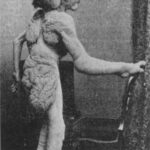Joseph Paxton’s design for the Crystal Palace in London in the 1850s was both innovative and revolutionary in its design. Apart from being a phenomenal structure to look at, the design of the Crystal Palace also gave rise to raising both philosophical and ideological implications on the choice of glass as an architectural material. The very idea of using architectural design as an ideological symbol has only recently become a subject of theoretical analysis, though its implicit use as a political statement goes back as far the art form itself. The conceptual use of glass as a symbol of vision allows for an elasticity of analysis that includes looking at, being looked at, and looking at while being looked at. The Crystal Palace is considered an emblem of the move toward modernity, an enclosure for the exhibition of value objects that looked forward to Walter Benjamin’s conception of exhibitionary value, yet both Paxton’s sketches and Camille Pissarro’s paintings of the structure reveal a vision that seems content with a merely utilitarian conception.
Glass as a symbol of panoptical ideology-especially as utilized in Paxton’s Crystal Palace-is especially open to interpretation; often interpretation that oversteps the boundaries of intention. The complete opacity of glass offers the spectator a glimpse into another room, yet also leaves the viewer vulnerable to becoming an object of voyeurism. Some view this as a reversal of the idea of the Jeremy Bentham’s Panopticon, suggesting that while that structure was designed with the express purpose of allowing everyone to be seen, the Crystal Palace was instead designed so that everyone inside could see out. Although that argument sounds well reasoned on the surface, one must keep in mind that the Panopticon was designed with ideological purpose in mind, that of control through surveillance, whereas the Crystal Palace was designed with only one specific purpose in mind: to house the Great Exhibition of 1851. Nothing exists in the writings left behind by Paxton to give any indication of an ideological purpose behind his construction of the Crystal Palace, and his sketches hardly indicate any intention beyond making a name for himself. Although there can be little question that all architecture does have an ideological component as Walter Benjamin and Michel Foucault argue, there also exist sthe argument that the ideology does not spring from the intent of the architect.
The sense here is that the political functions of architecture are covert. Paxton’s sketches were quickly designed, almost offhandedly, giving him doubtless little time to think about such things as the ideological meanings behind using glass as a building material. For Paxton, glass was simply available and experiential; he had worked in the medium before. The glass held no deeper meaning for him, the call had gone out for a building in which to house an exhibition. An exhibition was something that by its very nature needed to engender an ease with which it could be viewed.
It is not difficult to suppose that Camille Pissarro viewed the great glass structure in much the same way. Pissaro’s painting of the Crystal Palace, a subject he went back to twelve times, do not frame the subject of a glass building in a way that presupposes its function as an emblem of modernity or as an ideological statement. For Pissarro, like Paxton, the glass functions in a predominantly utilitarian way. Glass for Paxton functioned as the best way to achieve exhibition; for Pissarro the glass functioned in much the same was as the haystacks functioned for fellow impressionist painter Claude Monet, as an interesting subject for capturing the unique differences in the behavior of light. For the Impressionists, nothing mattered more than light. Claude Monet painted haystacks over and over, at various times of day, capturing the varying effects of light upon his subject. Pissarro returned to the Crystal Palace because he saw it as a perfect subject for capturing the effects of light. It was the world’s largest prism.
Architecture can and should be critiqued as ideological messages, but the mistake lies in assuming ideological intent among designers. Just as Foucault announced the death of the artist as a way of shifting the burden of the critique of a book’s meaning onto the reader, so should the ideology of a piece of architecture be taken away from the architect. For the Crystal Palace, it’s easy enough to see that glass functions ideologically for critics, but functionally for architects and painters. Paxton and Pissarro both saw in the use of glass a perfectly utilitarian use that applied to both their choice of medium.



